August 26 Column: The Enabling Garden
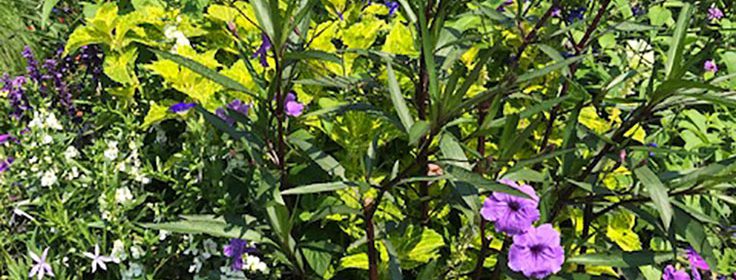
I was in Chicago last week for a conference hosted by the Association for Garden Communicators. Chicago is an amazing place with so many green spaces and gardens to enjoy. One of the gardens we visited is the Chicago Botanic Garden. For my column today, I decided to write about their Buehler Enabling Garden because there were so many usable ideas to share with you. Here’s a link to it in today’s edition of The Spokesman-Review: Enabling Garden offers ideas for accessible gardening. (or you can read my column lower in this post)
Enabling garden goals and definition
So what is an enabling garden anyway? Well, it’s a garden that is designed for individuals with either physical or sensory challenges so they can enjoy being in, and working in, the space. The Buehler Enabling Garden was a perfect example of just that.
It suggested the use of colors, textures and tactile cues to help folks who had limited or no vision, and ways to make gardening easier for those who could use some extra physical assistance. I hope you will find this information useful, particularly if you or a family member or friend are looking for ways to continue gardening.
Here are some photos from the garden. Remember that this week’s video is below them.
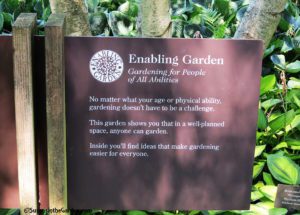
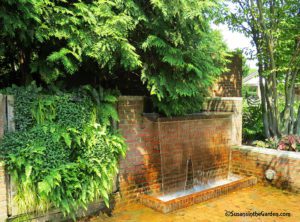
The above photo shows the waterfall and a vertical garden on the left.
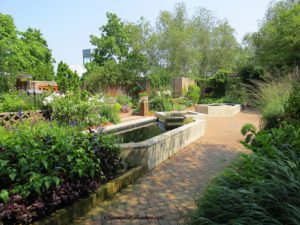
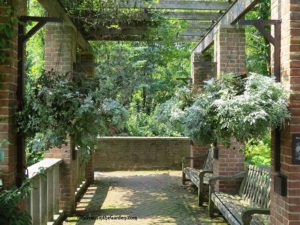
In the photo above, you can see some of the hanging baskets on pulleys that I mentioned in my column.
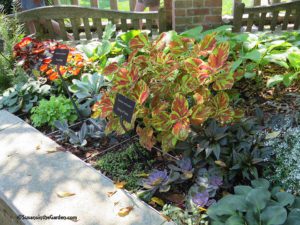
The above photo (you’ll probably need to click on it for a larger view) shows a metal grid. Visually-challenged gardeners can use to count the squares in order to locate specific plants. Pretty ingenious.
This week’s “Everyone Can Grow A Garden” video is part two of my Q&A video. It’s a little shorter than last week’s part one video. I’m hoping it contains helpful answers to questions that you just might have!
Garden column: Enabling Gardens
By Susan Mulvihill
I’ve just returned from this year’s garden writers’ conference which took place in Chicago. I was so impressed with the city’s many green spaces, colorful container plantings and beautiful gardens.
One of the most memorable stops was the Chicago Botanic Garden. I heartily recommend it to all of the garden-lovers out there. While strolling through the different regions within it, I was most inspired by the Buehler Enabling Garden. It’s billed as a “teaching garden that encourages gardening for people of all ages and abilities.” This garden offers excellent take-home ideas for those with sensory or physical limitations. The goal is to help them experience the many delights of a garden.
Enabling garden: Textures and Fragrances
In one area, the designers focused on textures, fragrances and tactile cues to assist visually-impaired gardeners. Soft, fuzzy plants such as lamb’s ear (Stachys byzantina), celosia spikes, and purple fountain grass (Pennisetum setaceum Rubra) added interest and texture. Aromatic herbs, scented geraniums, heliotrope and chocolate cosmos provided fragrant ways to locate specific plants. They pleased the senses as well. One ingenious idea involved placing a large-holed metal grid on the surface of a bed. That way, a gardener can count the squares in order to zero in on a certain plant. Cattle panels would be a way to implement this.
Enabling garden: Sounds
Water features — fountains, small pools, cascading waterfalls — provided pleasing sights, sounds and sensations. All were designed to increase one’s enjoyment of the garden.
There were plenty of useful ideas for gardeners who could use a bit of physical help. The goal was to help them in pursuing their passion for growing things:
Enabling garden: Accessibility
Raised beds are a perfect example of this as they make it easier to reach plants. They can be as tall as is needed, provided the beds are narrow enough for reaching across. Many of the walls of the beds offered a comfortable place to sit while tending plants.
Tall containers filled with bright, colorful plants were another idea, both for folks who need to garden from a seated position and for those with limited vision. Plantings included intensely-colored zinnias and Gloriosa daisies (Rudbeckia hirta), caladiums, the gorgeous silvery-purple Persian shield (Strobilanthes dyerianus), and many coleus in eye-popping colors.
One creative suggestion was to install a vertical wall garden where plants can be tended and enjoyed while standing or sitting. Elevated “shallow pan” containers also permitted seated gardening with clearance for wheelchairs underneath. I enjoyed seeing the hanging baskets which were each connected to an easy-to-use pulley system. This allows one to lower the baskets for planting, deadheading spent blossoms or pruning foliage and then raise them up to a safe height for head clearance.
The garden was paved with level, smooth bricks both to make walking safe and to provide easy access for individuals who use wheelchairs or walkers. The pathways were also wide enough to maneuver in.
The sign at the entrance to the enabling garden reaffirmed what I’ve always felt:
“No matter what your age or physical ability, gardening doesn’t have to be a challenge. This garden shows you that in a well-planned space, anyone can garden.”
I firmly believe that all individuals should have the opportunity to grow a garden and the ideas demonstrated at the Chicago Botanic Garden are a great starting point to make that possible.
Would you like more information?
Learn more about the Chicago Botanic Garden’s Buehler Enabling Garden by visiting www.chicagobotanic.org/gardens/enabling.

